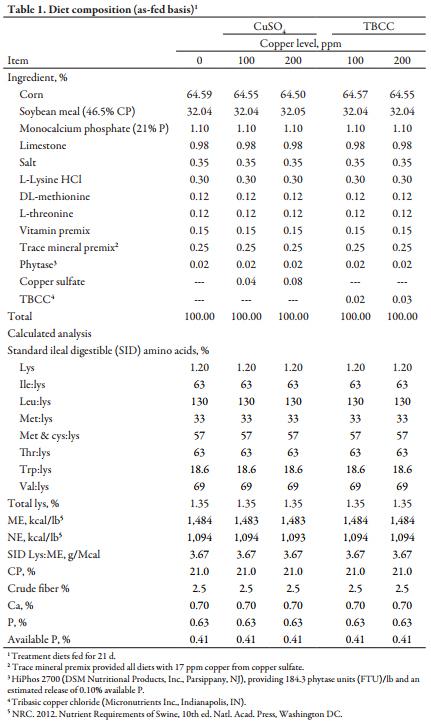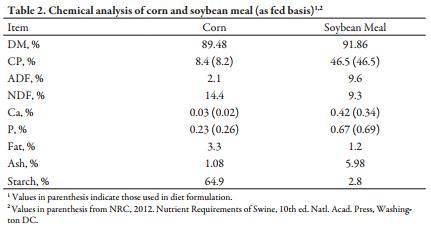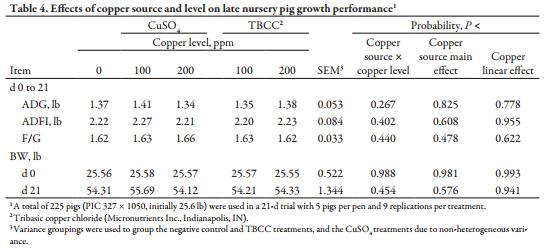Introduction
Research has shown that adding high levels of copper (primarily from CuSO4 ) to diets fed to nursery pigs will result in improved growth performance. It is thought that copper acts as an antimicrobial-like feed additive in the gut of the young pig, which influences the microflora in the intestine and leads to improvements in growth performance. Copper also has been shown to improve ADG and F/G during early finishing when fed as either CuSO4 or tribasic copper chloride (TBCC) (Hastad et al., 2001)2. More recently, Coble et al. (2014) has shown that TBCC can improve growth performance during early and late finishing. However, little data currently exists to compare the effects of CuSO4 and TBCC on late nursery pig growth performance. Thus, the objective of this experiment was to compare the effects of added Cu from either CuSO4 or TBCC on pigs fed from 25 to 50 lb.
Procedures
The Kansas State University Institutional Animal Care and Use Committee approved the protocol used in this experiment. The study was conducted at the K-State Swine Teaching and Research Center in Manhattan, KS.
A total of 225 pigs (PIC 327 × 1050, initially 25.5 lb) were used in a 21-d growth trial. Pigs were allotted to pens by initial BW so pen initial average BW was similar among pens. Pens were then assigned to treatments in a completely randomized design with 5 pigs per pen and 9 replications per treatment. Before the start of the experiment, from approximately 15 to 25 lb, all pigs were fed a common phase 2 diet that contained added Zn and Cu levels of 1,965 and 17 ppm, respectively. The 5 treatment diets were arranged in a 2 × 2 + 1 factorial with main effects of copper source (CuSO4 vs TBCC) and concentration (100 vs 200 ppm) with the addition of a negative control diet containing no additional copper (Table 1). All diets contained 17 ppm of Cu from CuSO4 from the trace mineral premix and were formulated to a constant standardized ileal digestible (SID) lysine level. All diets were fed in meal form and were prepared at the O.H. Kruse Feed Technology and Innovation Center (Kansas State University, Manhattan, KS).
Pigs were housed in 2 separate but identical rooms. Each pen contained a 4-hole, dry self-feeder and a nipple waterer to provide ad libitum access to feed and water. Pens had wire-mesh floors and allowed approximately 3 ft2 /pig. Pig weight and feed disappearance were measured on d 0, 7, 14, and 21 of the trial to determine ADG, ADFI, and F/G.
Samples of corn and soybean meal, and complete diets were collected and submitted for analysis of DM, CP, ADF, NDF, crude fiber, fat, starch, Ca, and P (Ward Laboratories, Inc., Kearney, NE; Tables 2 and 3). In addition, complete diet samples were submitted for copper analysis to Cumberland Valley Analytical Services (Maugansville, MD).
Data were analyzed as a completely randomized design using the PROC GLIMMIX procedure of SAS (SAS Institute, Inc., Cary, NC), with pen as the experimental unit. Evaluation of residuals indicated heterogeneous variance among treatment groups. Establishing 2 residual variance groups resulted in the best model fit. Room was used as a random effect in the model. Pre-planned contrast statements were utilized to determine the interaction of copper source and level, the linear effect of copper, main effect of copper, and main effect of increasing copper. Treatment differences were considered significant at P < 0.05 and were considered tendencies between P > 0.05 and P < 0.10.
Results and Discussion
The chemical analysis of the corn and soybean meal revealed that most nutrients were similar to formulated values. Calcium levels were slightly higher for soybean meal than formulated values. As expected, analysis of the dietary treatments showed increasing amounts of copper when CuSO4 or TBCC was added to the diet. All other nutrients were similar across treatments.
Overall (d 0 to 21), no copper source × copper level interactions (P > 0.10) were observed for any growth criteria (Table 4). There were also no effects (P > 0.10) of added copper, copper level, or copper source.
These data suggest that adding additional copper to phase 3 diets did not lead to improved growth performance. The lack of response may be related to the inclusion of high levels of Zn that was in the diet fed immediately prior to the study. High levels of Zn from ZnO are also known to have carryover effects, and other data suggest high levels of copper and zinc in nursery diets are not additive. Because we did not observe a Cu response, we also were unable to determine if the different Cu sources influenced growth performance differently. More research should be conducted to determine if a late nursery Cu response is dependent on the presence of high Zn concentrations in earlier diets.
This article was originally published in Kansas Agricultural Experiment Station Research Reports: Vol. 1: Iss. 7. https://doi.org/ 10.4148/2378-5977.1135. This is an Open Access article licensed under a Creative Commons Attribution 4.0 License.























